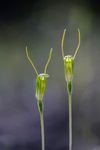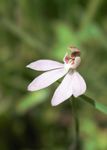Monument Hill Reserve, Kilmore - Mitchell Shire Council
←
→
Page content transcription
If your browser does not render page correctly, please read the page content below
Monument Hill Reserve, Kilmore
Blue Fingers Orchid
Cyanicula caerulia
Other names: Caladenia caerulia (formerly), Blue Caladenia,
Blue Fairy,
Description: A slender plant up to 180mm tall with leaves 70mm
long and 5mm wide. Generally, has a single flower with petals
and sepals up to 20mm long, with blueish hairs on the back. The
inner petal is blue and occasionally white. Three-lobed labellum,
sometimes bright yellow, 7-10mm column.
Flowering. July to October in Victoria, before dying back in hot
weather.
Habitat. Open woodlands and scrub, often along ridgelines.
Favours shallow, stony soils and semi-shade.
Distribution: A common orchid occurring across eastern
mainland Australia and southwest Western Australia. Central
Victoria boasts the highest density of this species in the state.
Uses. The tuber is harvested as aboriginal bushfood.
Conservation. Some peripheral populations of C. caerulia are
locally significant. This orchid hybridises with several other
species, including Glossodia major.
Photo credit © Alison Curnow
Wax-lip Orchid
Glossodia major
Other names: Purple Cockatoo.
Description: Very slender plant reaching up to 350mm in height.
Hairy leaf up to 100mm long and 5mm wide. Each plant has 1-2
flowers with petals and sepals up to 25mm long, with pale hairy
backs. The inner petal is purple-mauve and occasionally white.
Two-lobed white and purple labellum, with a bright yellow head,
and 10mm column. G. major has a vanilla-like fragrance.
Flowering. September-November.
Habitat. Occurs commonly in dry open forests, woodlands and
coastal heaths. Prefers well-drained soils in full sun to semi-
shade. Tends to proliferate after fires.
Distribution: All of Australia, except Northern Territory. G.
major is locally common, tending to form large colony patches.
Uses. Its small tubers are harvested as Aboriginal bushfood.
Conservation. This orchid hybridises with several other species,
including Cyanicula caerulia and Pheladenia deformis. Its
reliance upon a single species of root fungus makes colonies
somewhat vulnerable to environmental change (Warcup,1971).
Photo credit © Alison CurnowBlue Fairy Orchid
Pheladenia deformis
Other Names: Caladenia deformis (formerly), Bluebeard Caladenia
Description. 150mm high slender plant with a single faintly sweet-
smelling violet-blue flower, with a compact purple bristly-looking
15mm long labellum, a 7-10mm long column and scattered fine hairs
across its petals. Its leaves reach 80mm long and 4mm wide.
Flowering. May-September, triggered by fire in the previous
season.
Habitat. Widespread and locally common in south and central
Victoria, but uncommon across much of its broader range. Forms
tuberous clumps in sand, gravel and sandy loam. Favours swamps,
wet areas and outcrops in dry box forest and coastal heathland.
Distribution: All states except Queensland and Northern Territories.
Conservation. This orchid hybridises with Glossodia major, creating
a hybrid called xGlossadenia tutelata.
Photo credit © Alison Curnow
Pink Fingers Orchid
Caladenia carnea
Other names: Pink Fairies.
Description: Slender plant reaching 250mm high, with a single
narrow 150mm long, 4mm wide slightly hairy leaf and 1-3 flowers
with a sweet or musky scent. The petals and sepals are up to
150mm long, and whiteish-pink or greenish-white in colour, with
sparse hairs on the outer surfaces, and a compact 3-lobed 10mm
long pinkish-white labellum with red lateral stripes and a yellow tip,
and a 6-8mm column with lateral red stripes. Greenish or reddish
slightly hairy stem and round tuber. Very variable across its range.
Flowering: August-December, but very variable indeed with regards
to flowering time. C. carnea dies back to a tuber in hot weather.
Habitat: Grows in a broad variety of habitats including sclerophyll
forest, coastal heath and woodland. C. carnea is disturbance
tolerant, and readily recolonises cleared areas. It forms sparse
colonies. Requires at least partial sunlight, typically occurring in
sandy or depauperate soils in both moist and well-drained positions.
Photo credit Daniel Young
Distribution: Occurs throughout eastern and south-eastern
Australia and Tasmania, and is widespread in Victoria.
Uses: Harvested by Aboriginals as edible tuber.
Conservation: Hybridises with other members of Caladenia. Its high variability makes it possible that C.
carnea is in fact a species complex with high local biodiversity of according conservation value.Dwarf Greenhood
Pterostylis nana
Description: 150mm tall slender stemmed plant with a rosette of
20mm long oval leaves. 15mm long erect green and white flower,
with erect lateral sepals.
Flowering: July-October.
Habitat: P. nana grows in a wide range of habitats including open
forest, mallee scrub and coastal heath. It favours sheltered areas in
open woodland, with well-drained soils. It is common in landscapes
where it occurs, typically forming small colonies. It is pollinated by
invertebrates.
Distribution. South-eastern Australia, Tasmania and New Zealand.
Conservation. P. nana is a complex of species of contested
taxonomic status subject to ongoing investigation. Localised
populations of P. nana hold potential for future analysis to identify
them as genetically distinct sub-groups in their own right, with
accordingly higher conservation significance.
Photo credit: © Alison Curnow
Nodding Greenhood
Pterostylis nutans.
Other names: Parrot’s Beak Orchid.
Description: A distinctive looking orchid growing up to 300mm,
with a single 25mm long translucent green and brown hoodlike
flower with a curved red beaklike apex, that “nods” in the wind; and
3-6 oval leaves of up to 40mm long, that form a rosette. Small
tuber.
Flowering: April-October to die back into a dormant tuber over
summer.
Habitat: Common and widespread in damp areas of dry sclerophyll
forest, wet forest and coastal scrub, growing from sea level to high
altitudes, where it forms both small and quite large colonies,
typically in damp leaf litter. P. nutans is insect pollinated, and
strongly dependant upon a single genus of soil fungus to grow
(Irwin et al, 2007).
Distribution: Eastern and south-eastern Australia and Tasmania,
with some vagrant populations in New Zealand of uncertain status.
Uses: An easily grown orchid that is commercially sold and grown
by both orchid enthusiasts and as a more general garden plant. P.
Photo credit: © Alison Curnow
nutans has a starchy and nutritious tuber that is consumed either
raw or cooked in Aboriginal bushfood (Zola & Gott, 1992).
Conservation: Can hybridise with other Pterostylis species, including the Blunt Greenhood (P. curta),
which also occurs on Monument Hill.Slender Onion Orchid
Microtis parviflora
Description. A fleshy flower spike growing up to 500mm tall, emerging
from half-way up a single erect tubular leaf of up to 400mm in length. It
has up to 80 densely packed tiny green 3-4mm flowers.
Flowering. October-February, stimulated by fire.
Habitat: A locally common and widespread native orchid occupying
diverse habitats in sclerophyll forests, bogs and wet grasslands. It
favours damp soils, but also occurs in seasonally dry winter wet
conditions. It prefers semi-shade. M. parviflora can form large
sprawling low-density clonal colonies in disturbed areas, even actively
colonising lawns, gardens and agricultural areas. The flowers are
pollinated by ants, especially the meat ant (Iridomyrmex purureus)
within the southern half of Victoria, which are attracted by a sweet
fragrance released on mild humid days (Jones, 1975). M. parviflora
has round tubers and is reliant on a single genus of soil fungus to grow
(Irwin et al, 2007).
Photo credit: Graham Jury Distribution: Southern and eastern Australia, Tasmania and NZ
Uses: Tuber harvested as Aboriginal bushfood.
Dotted Sun Orchid
Thelymitra ixiodes
Other Names: Spotted Sun Orchid
Description: Slender plant growing 600 mm tall with a grey-green or
reddish stem. Slender lance-like fleshy leaves up to 300mm long. 1-15
25mm-wide fragrant flowers with mauve or bright blue petals covered
in dark spots. Cup-shaped, yellow-tipped column up to 6mm long.
Fleshy egg-shaped tubers. T. ixiodes is highly variable and subject to
ongoing debate over its biodiversity and classification, though two
distinct separate subspecies are generally recognised.
Flowering. Core season is October-November though also flowers a
few months either side of this window, before dying back to a tuber in
hotter weather. It has stringent moisture and light level requirements
and will readily abort flowering for a season without optimal conditions.
The flowers open on warm days.
Habitat. T. ixiodes is one of the most common species in the
Thelymitra genus. It grows in a wide range of habitats including
grasslands, open woodlands, swamps and sandy heaths, often
forming large, localised patches. It can grow in heavily depauperate
Photo credit © Alison Curnow soils and often occurs on rural roadsides and is insect-pollinated.
Distribution: Widespread across southern and eastern Australia and Tasmania. Also native to New
Caledonia and New Zealand.
Uses: Cultivated by orchid enthusiasts and occasionally sold commercially. Its fleshy tubers are harvested
as aboriginal bushfood.
Conservation. This orchid hybridises with several other species of Thelymitra. While common in Victoria, it
is endangered in South AustraliaLeopard Orchid
Diuris pardina
Other Names: Diuris maculata (formerly), Burny Burny
Description: 400mm high plant with 2-3 leaves growing up to
300mm long and 4mm wide, and 1-8 yellow nectarless flowers
with brown markings. 5-9mm three-lobed labellum that is shorter
than the dorsal sepal. The tuber is oblong-conical in shape.
Different forms of D. maculata occur across its range.
Flowering. August-October
Habitat: Amongst the commonest orchids in southeast Australia,
and locally common around the Macedon Ranges, D. pardina
grows amongst grass in sclerophyll forest, heath and scrub, either
singly or in small groups, across varied soil types. The colour and
shape of this flower have evolved to mimic various “egg and
bacon” pea flowers belonging to Pultenaea and Daviesia, in order
to attract pollination by legume-specialised nectar-feeding bees
(Indsto et al, 2006). Its high variability is believed to correspond to
it mimicking different ecological arrays of host plant in different
areas. It readily spreads clonally though tubers.
Distribution. Southeast Australia and Tasmania.
Photo credit © Alison Curnow
Conservation. Readily hybridises with other Diuris species,
including D. orientis. D. pardina is a complex of species, of
contested taxonomic status subject to ongoing investigation. Localised populations of D. pardina hold
potential for future analysis to identify them as genetically distinct sub-groups of this species, with
according conservation significance.
Wallflower Donkey Orchid.
Diuris orientis
Description: A reasonably stout plant reaching 400mm tall., with
1-3 lancelike leaves reaching 300mm. It has 3-5 yellow flowers,
with flushes of purple and reddish brown, and has a forward
projecting blended dark reddish, yellow and purple three-lobed
labellum, reaching 14mm. D. orientis is variable across its range.
Flowering: Typically September-November, most prolifically after
fire.
Habitat: Locally common in woodlands and heaths where it grows
amongst grass in well-drained soils in semi-shade. Monument Hill
is near the northern edge of its core range in Victoria.
Distribution: South-east Australia and Tasmania.
Uses: A commercially grown orchid, used in landscaped
woodlands.
Conservation: Hybridises with other Diuris species, including D.
pardina.
Photo credit: Daniel YoungGraham Jury Tailored Restoration Ecology and Conservation Land Services, 2021. References Australian Native Plants Society. 2021. www.anpsa.org.au Beardsell, D., M. Clements, J. Hutchison & E. Williams. 1987. “Pollination of Diuris maculata R.Br.(Orchidaceae) by Floral Mimicry of the Native Legumes Daviesia spp. and Pultenaea scabra R.Br.”, Australian Journal of Botany, 34, 165-73. Castlemaine Flora, 2021. www.castlemaineflora.org.au FloraSA. 2021. www.flora.sa.gov.au Flora of Victoria, 2021. www.vicflora.rbg.vic.gov.au Indsto, J., P. Weston, M. Clements, A. Dyer, M. Batley & R. Whelan. 2006. “Pollination of Diuris maculata (Orchidaceae) by male Trichocolletes venustus bees”, Australian Journal of Botany, 54, 669-79. Irwin, M, J. Bougoure & J. Dearnaley. 2007. “Pterostylis nutans (Orchidaceae) has a Specific Association with Two Ceratobasidum Root-associated Fungi Across its Range in Eastern Australia”, Mycoscience, 48. Pp 231-9. Jones, D. 1975. “The Pollination of Microtis parviflora R.Br.”, Annals of Botany, 39.3 pp 585-9. Nurseries Online Australia. 2021. www.nurseriesonline.com.au Plantnet, 2021. www.plantnet.rbgsyd.nsw.gov.au/ Yarra Ranges Plant Directory.2021. www.yarraranges.viv.gov.au/plantdirectory Warcup, J. 1971. “Specificity of Mycorrhizal Association in Some Australian Terrestrial Orchids”, New Phytologist, 70.1. pp 41-6. Zola, N & B. Gott. 1992. “Koorie Plants, Koorie People: Traditional Aboriginal Food, Fibre and Healing Plants of Victoria, Koorie Heritage Trust, Melbourne.
You can also read



























































